Back in issue 15 of Singletrack Magazine, in 2004, we reviewed three of what were then a new development: women’s specific bikes. We followed it up with a head to head pair of columns from Joolze Dymond and Jenn Hill, complete with ironic pink and flowery design. You can read these here, 19 years later, and consider: how far have we come? We’ve got a few words from Joolze at the end too. Has she changed her views since she wrote this?
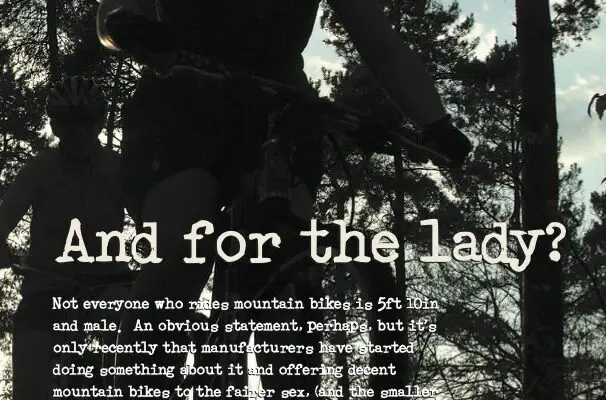
Does the world need more niche bikes? The manufacturers of women’s-specific geometry bikes seem to think so. Here to argue both sides of the coin are two of Singletrack’s opinionated ladies of letters, Joolz Dymond and Jenn Hopkins.
Here’s what Joolze had to say…
I think I’m one of the lucky ones… At 5ft7in I’ve never had a problem finding a bike to fit me. I’ve also been quite lucky that I’ve also had the aptitude, inclination and facilities to tweak and change bits that I didn’t like. As a result 25 years later I’m still enjoying the sport.
So I’m lucky. But I also know a lot of women who have tried to get into the sport, some with success, some without. One of their major stumbling points being – their height, oh and the fact they are a woman…
The average height for women these days is 5ft4in, weighing in around 135lbs. The height of the average man is 5ft9in and 175lbs. Now when you realise that the geometry and ride quality of most frames are designed for this average man, you can possibly understand why women (and come to that, shorter men) struggle with the comfort of, off the peg bikes. Typically smaller bikes are just scaled down versions of the bigger models, including the same geometry, tubeset, suspension and running gear. This usually means the top tube just gets shorter, along with the wheelbase, resulting in an unstable ride. Exciting for some, horrific for the beginner…
As a result you end up with a frame that is simply overbuilt for the average female. Sluggish suspension, wide bars, brake levers difficult to reach, and don’t mention that razor blade excuse for a saddle.
Okay now some of these bits you can change yourself. But why should you go to the trouble and expense of changing standard bits of kit, to ones which are better suited to the job, when there are bikes out there better equipped at no extra cost. Off the peg is one of the cheapest ways to purchase your initial bike. It’s all there; a good frame with shiny bits attached that will transform your life. Get it right and you’ll get years of enjoyment and a whole new aspect to your life. Get it wrong, and it’ll be a costly expense you’ll never forgive or give a second chance too.
This is why the emergence of mainstream women-specific bikes is a good thing. It gives women a more informed choice. A choice which may mean a life long love affair with the sport rather than a flash in the pan horror experience.
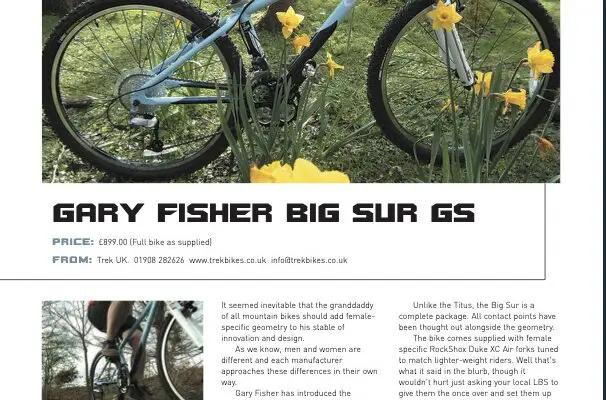
Now smaller women and shorter stature men no longer need to mortgage the kids to get a custom built bike that fits, or end up compromising and fiddling with mainstream equipment in the endless pursuit of achieving the impossible (if the bike don’t fit, it just don’t fit…)
Most of the major players in the bicycle trade now offer a couple of bikes that are women/vertically challenged friendly. No they’re not just scaled down versions, they are an investment in encouraging the other 50% of the population to get on a decent lightweight bike and enjoy the experience.
True women’s specific bikes will specify lighter tubing, for a lighter frame, they’ll also opt for women’s specific suspension, using lighter oils, and tuned for the lighter rider.
You’ll find the geometry adjusted accordingly – women’s pelvic bones are wider than our male counterpart and this affects how we sit, and in turn affects how we fit on a bike.
With this in mind you’ll find WSD bikes with shorter toptubes for easier reach coupled with a steeper seat angle to position you over the pedals correctly and a slacker headtube angle to achieve a more stable wheelbase. But the differences don’t stop there, WSD are usually equipped with female friendly equipment, this doesn’t just mean a comfy mattress-style saddle either. You’ll find 170mm cranks instead of the usual 175mm. Reason? Women’s femurs are shorter than their male counterparts, so the shorter crank enables her to pedal more efficiently.
You’ll also find, smaller brake levers, positioned closer to the bars. Reason? Women generally have small hands and find regular equipment too much of a stretch and in some cases too much of a handful.
If you spend wisely you’ll also find bikes out there that come equipped with light wheelsets. Why ride 36 or even 32 hole spoke wheels when you can ride comfortably on 24/28 wheel packages (check out Gary Fisher Big Sur GS). The rotating weight of the wheelset can make a big difference in the way the bike responds, whether going quickly or slowly.
Then there are the handlebars, generally narrower than on standard bikes to accommodate a female’s narrower shoulders. Don’t worry if your dream bike is only equipped with V-brakes, chances are that’s all you’ll need. Discs are great in wet weather but come with a weight penalty, you’ll find that V’s work better for the lighter rider, especially in the dry.
With all this in mind, don’t forget that buying a new bike is a truly personal experience. So try, try and try again until you get a bike that YOU like and feel comfortable and in control, it may be women’s specific it may not, but at least now you have the choice to decide. Also remember that what’s cool for the guys may not be cool for you. Choose wisely and you’ll be kicking dust into the faces of the men as you sprint up that hill.
- Joolze
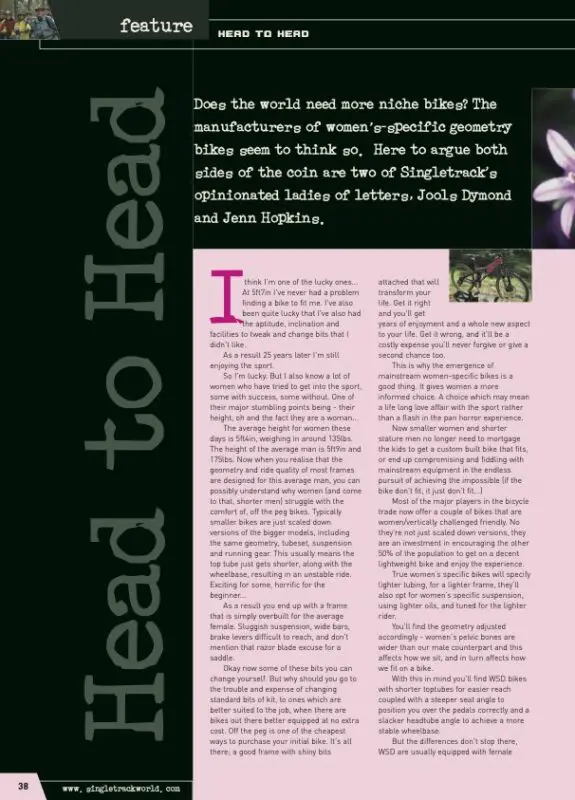
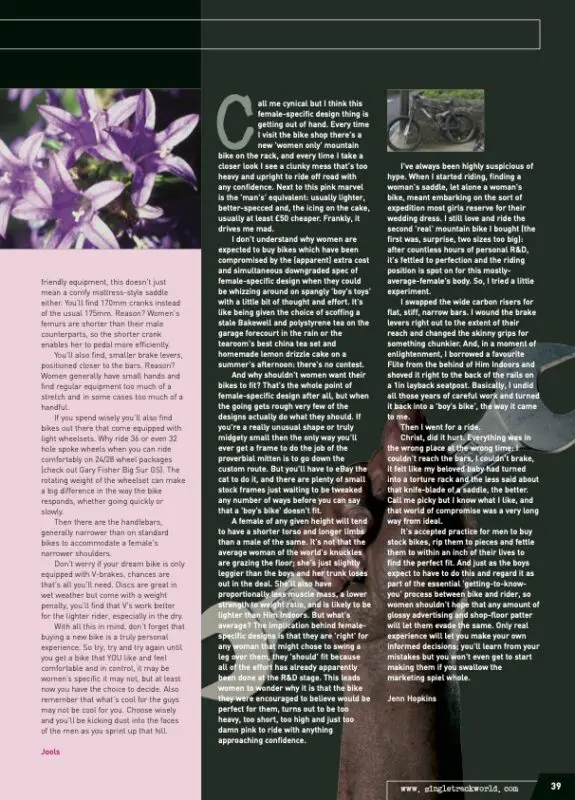
And here’s what Jenn thought on the matter:
Call me cynical but I think this female-specific design thing is getting out of hand. Every time I visit the bike shop there’s a new ‘women only’ mountain bike on the rack, and every time I take a closer look I see a clunky mess that’s too heavy and upright to ride off road with any confidence. Next to this pink marvel is the ‘man’s’ equivalent: usually lighter, better-specced and, the icing on the cake, usually at least £50 cheaper. Frankly, it drives me mad.
I don’t understand why women are expected to buy bikes which have been compromised by the (apparent) extra cost and simultaneous downgraded spec of female-specific design when they could be whizzing around on spangly ‘boy’s toys’ with a little bit of thought and effort. It’s like being given the choice of scoffing a stale Bakewell and polystyrene tea on the garage forecourt in the rain or the tearoom’s best china tea set and homemade lemon drizzle cake on a summer’s afternoon: there’s no contest.
And why shouldn’t women want their bikes to fit? That’s the whole point of female-specific design after all, but when the going gets rough very few of the designs actually do what they should. If you’re a really unusual shape or truly midgety small then the only way you’ll ever get a frame to do the job of the proverbial mitten is to go down the custom route. But you’ll have to eBay the cat to do it, and there are plenty of small stock frames just waiting to be tweaked any number of ways before you can say that a ‘boy’s bike’ doesn’t fit.
A female of any given height will tend to have a shorter torso and longer limbs than a male of the same. It’s not that the average woman of the world’s knuckles are grazing the floor; she’s just slightly leggier than the boys and her trunk loses out in the deal. She’ll also have proportionally less muscle mass, a lower strength to weight ratio, and is likely to be lighter than Him Indoors. But what’s average? The implication behind female- specific designs is that they are ‘right’ for any woman that might chose to swing a leg over them, they ‘should’ fit because all of the effort has already apparently been done at the R&D stage. This leads women to wonder why it is that the bike they were encouraged to believe would be perfect for them, turns out to be too heavy, too short, too high and just too damn pink to ride with anything approaching confidence.
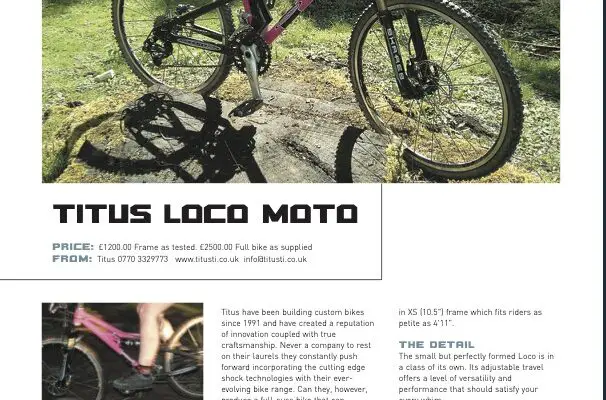
I’ve always been highly suspicious of hype. When I started riding, finding a woman’s saddle, let alone a woman’s bike, meant embarking on the sort of expedition most girls reserve for their wedding dress. I still love and ride the second ‘real’ mountain bike I bought (the first was, surprise, two sizes too big): after countless hours of personal R&D, it’s fettled to perfection and the riding position is spot on for this mostly- average-female’s body. So, I tried a little experiment.
I swapped the wide carbon risers for flat, stiff, narrow bars. I wound the brake levers right out to the extent of their reach and changed the skinny grips for something chunkier. And, in a moment of enlightenment, I borrowed a favourite Flite from the behind of Him Indoors and shoved it right to the back of the rails on a 1in layback seatpost. Basically, I undid all those years of careful work and turned it back into a ‘boy’s bike’, the way it came to me.
Then I went for a ride.
Christ, did it hurt. Everything was in the wrong place at the wrong time: I couldn’t reach the bars, I couldn’t brake, it felt like my beloved baby had turned into a torture rack and the less said about that knife-blade of a saddle, the better. Call me picky but I know what I like, and that world of compromise was a very long way from ideal.
It’s accepted practice for men to buy stock bikes, rip them to pieces and fettle them to within an inch of their lives to find the perfect fit. And just as the boys expect to have to do this and regard it as part of the essential ‘getting-to-know- you’ process between bike and rider, so women shouldn’t hope that any amount of glossy advertising and shop-floor patter will let them evade the same. Only real experience will let you make your own informed decisions; you’ll learn from your mistakes but you won’t even get to start making them if you swallow the marketing spiel whole.
- Jenn Hopkins

Of course, we sadly can’t ask Jenn what she makes of the bike world today, but Joolze has given her column from back then some reflection. Here’s what she has to say:
There is no right or wrong answer. This pretty much sums up where I was 19 years ago when writing about the influx of women specific bikes on the market. Back then I considered this option as an ‘in’ for a lot of petite women (and in some cases men) who struggled to get a bike that would suit their needs. There were a lot of flaws. Mainly the pink it and shrink it attitude by a lot of brands, that charged you extra for less, did the concept no justice.
The intentions were good, but the execution left a lot to be desired and unfortunately buying a bike off the shelf isn’t an exact science for any of us. Ask any of your friends and you’ll find everyone has their preferences of how their bike is set up, saddle choice, bar width etc and probably all have tweaked parts of their ride to suit them.
So were are we now?
There are still a few brands that offer a ‘womens’ specific’ build, but the advice still stays the same:
Find yourself a good bike shop, ride a number of bikes to find something that feels good, that good bike shop should go out of its way to help you tweak that bike to suit you perfectly and you may find the women’s specific doesn’t suit you, but at least you have the option.
What do I ride now?
I followed my own advice. Test rode a few bikes, borrowed friends’ bikes, and found a bike that made me feel instantly comfortable and in control. I was able to buy a frameset and then build it up with the parts I knew suited me. That bike – a Kinesis Sync.
6 years on its still going strong. Takes me on numerous adventures and makes me smile every time I ride.
Joolze Dymond
What changes have you seen in your time riding bikes? And what do you hope comes next? Head to the comments, or hop on over to read Hannah’s take on things.
While you’re here…
Join our mailing list to receive Singletrack editorial wisdom directly in your inbox.
Each newsletter is headed up by an exclusive editorial from our team and includes stories and news you don’t want to miss.




You must be logged in to reply to this topic.